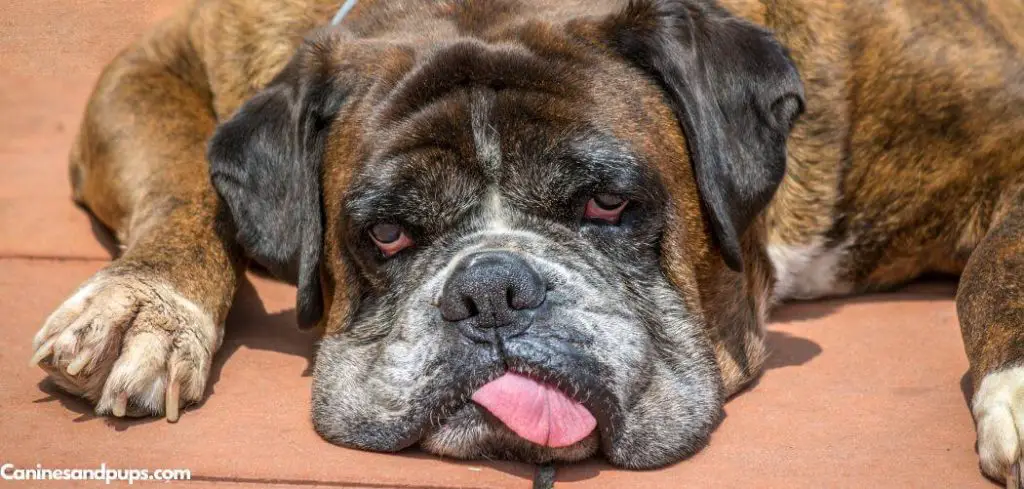Panting paired with gulping in dogs can be a sign of an underlying issue that needs attention. While occasional panting is normal after exercise or excitement, gulping—especially when combined with rapid or labored breathing—may indicate stress or a medical condition that requires evaluation.
We outline the common causes of dog panting and gulping, what you can do at home, and when to seek veterinary help.
Dog Panting and Gulping — Why It Happens
Dog panting and gulping often happen when a dog is experiencing nausea, acid reflux, or discomfort in the throat or stomach. The gulping can be an attempt to swallow excess saliva or soothe irritation caused by acid or gas, while the panting reflects anxiety, discomfort, or mild pain from the digestive upset.
This combination can also occur if your dog has eaten too quickly, ingested something irritating, or is dealing with bloating or an obstruction. In some cases, it’s triggered by stress or a neurological issue that affects swallowing.

Dog Panting and Gulping: Common Causes
Anxiety and Stress
An anxious or stressed dog may pant excessively and gulp frequently. Panting and gulping occur as part of the body’s “fight or flight” response, releasing adrenaline and increasing oxygen intake.
Signs include pacing, whining, trembling, or avoidance behaviors. This combination can persist during stressful situations like thunderstorms, fireworks, or separation. While anxiety is not always dangerous, chronic stress can lead to long-term health issues and requires management through training, environmental adjustments, or, in some cases, veterinary guidance.
Read more: Dog Panting and Gasping (Here’s why)
Pain or Discomfort
Pain—whether from injury, arthritis, or internal illness—can trigger panting and gulping. Dogs in pain breathe faster to cope with discomfort, and gulping may occur as a reflexive response to nausea or digestive upset.
Owners might notice limping, reluctance to move, vocalization, or changes in behavior. Addressing the source of pain is critical, as untreated discomfort can escalate, affecting appetite, mobility, and overall quality of life.
Gastrointestinal Distress
Upset stomach, nausea, or acid reflux can make a dog gulp and pant simultaneously. Gulping often accompanies attempts to relieve discomfort or prevent vomiting.
Other signs include drooling, retching, vomiting, diarrhea, or loss of appetite. Gastrointestinal issues can range from mild dietary indiscretion to serious conditions like pancreatitis or bloat. Prompt evaluation is essential if symptoms persist or worsen.
Heat or Exercise Stress
Overheating from warm environments or strenuous activity may lead to panting and gulping. Dogs use panting to dissipate heat, while gulping often occurs if they become overly thirsty or anxious due to heat stress.
Signs of heat stress include excessive drooling, bright red gums, lethargy, or unsteady walking. Heat-related issues are potentially life-threatening, making immediate cooling and hydration critical.
Respiratory Conditions
Respiratory problems like bronchitis, pneumonia, or collapsing trachea can cause dogs to pant and gulp in an effort to increase oxygen intake. Labored breathing often triggers gulping motions as the dog struggles to get sufficient airflow.
Owners may notice coughing, wheezing, rapid or shallow breathing, or fatigue. Respiratory conditions can deteriorate rapidly, requiring veterinary intervention to manage oxygen levels, inflammation, or infection.
Cardiac Problems
Heart disease or heart failure may present as panting with gulping, as the body attempts to compensate for reduced oxygen circulation. The heart beats faster while the dog breathes rapidly, sometimes accompanied by gulping due to shortness of breath.
Signs include coughing, fainting, swollen abdomen, or exercise intolerance. Early detection and management of cardiac conditions are crucial to prevent severe complications and maintain quality of life.
What to Do If Your Dog Is Panting and Gulping
Move your dog to a calm, comfortable environment. Offer shade and good airflow to reduce stress or overheating.
Provide small amounts of water if your dog can drink safely. Avoid forcing fluids, which may cause choking or vomiting.
Observe your dog’s behavior and look for additional symptoms such as drooling, vomiting, lethargy, or changes in gum color. Documenting these observations helps your veterinarian make an accurate assessment.
Encourage rest and avoid strenuous activity until your dog’s breathing and gulping normalize. Limiting stressors or triggers can also help, especially if anxiety is a contributing factor.
Monitor your dog’s temperature if possible. A fever or elevated body temperature combined with panting and gulping may indicate infection, inflammation, or heat stress.
When to Call or Visit Your Vet
Seek veterinary care immediately if your dog’s panting and gulping are persistent, severe, or accompanied by collapse, fainting, bluish gums, or difficulty breathing.
Prompt attention is needed if your dog shows signs of vomiting, diarrhea, severe lethargy, or abdominal distension, as these may indicate digestive or systemic illness.
Dogs with pre-existing cardiac, respiratory, or endocrine conditions should be evaluated as soon as these symptoms appear, even if mild. Early intervention improves outcomes and prevents escalation of health issues.
Read more: Dog Panting and Gagging (What it means)
Key Takeaway
Panting and gulping in dogs can result from anxiety, pain, gastrointestinal upset, heat stress, respiratory problems, or heart conditions. While occasional panting or gulping may be normal, persistent or unexplained episodes require careful observation and prompt veterinary attention.
You can help by providing a cool, calm environment, offering water safely, monitoring behavior and vital signs, and reducing stress.
Documenting symptoms and seeking timely veterinary evaluation ensures proper diagnosis and treatment, improving your dog’s comfort and long-term health.
Recognizing the potential causes and responding quickly allows dog owners to protect their pets from serious complications, ensuring safety, comfort, and peace of mind.
